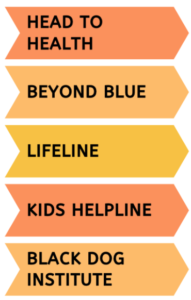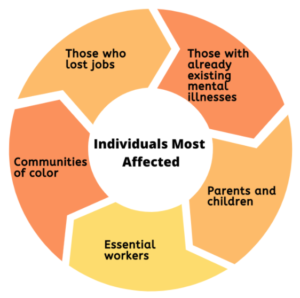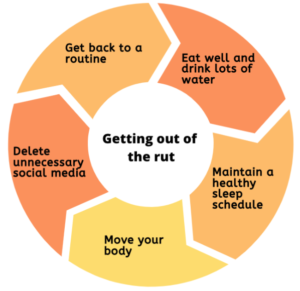Tackling the COVID-19 Mental Health toll
by Medha Shekhar
Over the past 30 years mental health disorders have been increasing with the rising global population and advancement of social media. Seen in the past as a “taboo,” topics such as clinical depression, bipolar disorder, anxiety, substance abuse, and PTSD have been recognized and destigmatized, allowing people to speak up about their history with these matters. However, normalized the subject is, there is still the issue of 1 in 4 individuals experiencing a form of mental illness. With the surge of the global pandemic, the distress that came with Covid-19 highlighted the need to improve mental health services within Australia. Forced to isolation and social distancing, people faced a massive shift in their day-to-day life, resulting in a drastic decline of their mental wellbeing.
The pandemic exposed areas of need in our society
Because of the major disruption in lifestyle, significant challenges were faced by the Australian population during Covid-19. With a short time to adapt, the pandemic brought upon both physical and mental issues to multiple communities, families and individuals. With higher levels of anxiety and psychological distress, many adults reported difficulty sleeping and eating as well as an increase in substance abuse and already existing chronic conditions. The worry over Covid affected the whole population; whether it was the fear of infecting a high-risk family member or just contracting the virus, stress levels were at an all-time high.
At the start of the pandemic, there was an absence of data collection to guide an effective response to the increasing stressors along with a lack of access to treatment and support. However, this raised concerns within global public health organizations who have recently started targeting mental health aid in communities. Amenities that should have been implemented before the virus needed to be addressed, however two years later, the government has made many support services available both in person and online that aim to tackle the stress of Covid-19.

You aren’t alone in this matter
The coronavirus has affected everybody differently, but it is important to note that if you are struggling with this pandemic, you are not alone.

Those who lost jobs
When everyone and everything went into lockdown, many workers lost their jobs due to the difficulty of simplifying job tasks and developing a more flexible virtual schedule. This led to higher rates of work stress as well as heightened depression and anxiety. With this came a lower self-esteem resulting in increasing rates of substance use and in worst cases, self-harm.
Communities of color
Social and racial injustice in the public health sector was an issue before the pandemic, and Covid-19 only emphasized the severity of this matter. Data shows that communities of color were statistically more at risk of contracting and dying from the virus because of their social determinants of health. Historically, they have not had an equal chance to opportunities such as insurance, child care, and ability; this has led to high levels of unhealthy mental health within groups of color.
Essential workers
Many essential employees, especially frontline health-care workers were put in a very tough position at the start of the pandemic and still brave many difficulties today. Faced with isolating themselves from their family and friends due to risk of infection, they also dealt with the life-or-death decisions, witnessing the cruelty of the virus firsthand. With a lack of staffing and heavy workload, essential workers worked long and grueling hours leading to a depletion of their mental health.
Parents and children
Many challenges were brought up for both parents and children because of schools closing. Parents who were essential workers had to deal with the stressor of lack of childcare due to social distancing rules. Children who relied on engaging in social activities dealt with loneliness and pent-up energy. Furthermore, young adults who were in high-school or university had to deal with a loss of income and independence leading to an increase in an already high number of adolescents with anxiety and/or depression.
Those with already existing mental illnesses
Because of social isolation, people with pre-existing mental health issues were at risk for worsening of their condition. Due to the sudden turnaround in routine, these individuals who often rely on following a strict schedule were unable to maintain a stable level of mental health. Many treatment centers were shut down and because of the lack of response, it took a while for online services to come into play.
How to get out of the Covid-19 rut

Get back to a routine
Lockdowns and social distancing are a major stressor for individuals and cause people to grow stuck on what they can’t control. It’s time to regain what we can control and create a routine. A routine can break the cycle of an unhealthy mindset. You can start small, getting rid of bad habits one at a time and instead begin subsisting them with something new and positive. It won’t happen overnight, but if you stick to the routine, you will soon find yourself in a much happier and healthier mood!
Delete unnecessary social media
Apps like TikTok and Instagram tend to promote unrealistic ways of living, especially during this pandemic. At times when you are supposed to be social distancing, it is hard to go online and see people gathering in large groups. There is no need to feel guilty for doing what is right, and there are healthier ways of staying up to date with your friends. It could be helpful to go on a social media detox; unfollow people who don’t make you feel good, and set boundaries around your social media time. Find ways to entertain yourself without your phone!
Move your body
Exercise has proven to be beneficial for both your physical and mental health. Whether it is going for a walk or riding your bicycle, moving your body stimulates chemicals responsible for improving your mood. It also helps you get outside and get some vitamin D from the sun! Trying to move your body every day can make a big difference. When you are feeling motivated to do strenuous exercise try HIIT, boxing, or running. If you feel low on energy, try a gentle exercise like yoga, Pilates, or walking!
Maintain a healthy sleep schedule
Sleep and mental health go both ways. If you maintain a disciplined morning and night routine, your psychological state will be healthier. You will also face less mental health problems associated with insomnia and other sleep disorders.
- Keep to a consistent time to bed and rise time (within a 30–60-minute window)
- Ensure your room temperature is somewhere between 18-20 degrees Celsius
- Avoid eating and drinking within 1-2 hours of scheduled bedtime
- Allow for 1–2 hours to wind down – no devices, blue light or stimulates of any kind
For further information on how to improve your sleep check out our webinar!
Eat well and drink lots of water
A healthy diet is associated with a happy mood. Eating fruits, vegetables, omega-3 fats, nuts, and legumes are associated with a lower risk of depression. Diets high in carbohydrates change your blood glucose level in the gut and often lead to the opposite, unhealthy effect. Drinking lots of alcohol and participating can affect your sleep schedule and increase your risk of mental health disorders as both are known depressants. Instead, lots of water should be consumed every day as it acts to improve your mood, mental health, and physical performance.
For further information on eating well check out our webinar!
Download our FREE e-book on Rewiring Ourselves in a Disconnected World!
References
CDC. “Health Equity Considerations and Racial and Ethnic Minority Groups.” Centers for Disease Control and Prevention, 9 Mar. 2022, https://www.cdc.gov/coronavirus/2019-ncov/community/health- equity/race-ethnicity.html.
“Creating Healthy Routines.” Mental Health America, https://mhanational.org/creating-healthy- routines. Accessed 27 Apr. 2022.
“Essential Workers More Likely to Be Diagnosed with a Mental Health Disorder during Pandemic.” American Psychological Association, Mar. 2021, https://www.apa.org/news/press/releases/stress/2021/one-year-pandemic-stress-essential.
Healthdirect Australia. “Food, Drink and Mental Health.” Healthdirect Australia, https://www.healthdirect.gov.au/food-drink-and-mental-health. Accessed 27 Apr. 2022.
“Mental Health Services in Australia.” Australian Institute of Health and Welfare, https://www.aihw.gov.au/reports/mental-health-services/mental-health-services-in-australia/report-contents/mental-health-impact-of-covid-19. Accessed 27 Apr. 2022.
National Mental Health and Wellbeing Pandemic Response Plan. https://www.mentalhealthcommission.gov.au/getmedia/1b7405ce-5d1a-44fc-b1e9-c00204614cb5/National-Mental-Health-and-Wellbeing-Pandemic-Response-Plan.
Rice-Oxley, Mark. “Mental Illness: Is There Really a Global Epidemic?” The Guardian, 3 June 2019, http://www.theguardian.com/society/2019/jun/03/mental-illness-is-there-really-a-global-epidemic.
“Sleep and Mental Health – Harvard Health Publishing.” Harvard Health, 17 Aug. 2021, https://www.health.harvard.edu/newsletter_article/sleep-and-mental-health.
Substantial Investment Needed to Avert Mental Health Crisis. https://www.who.int/news/item/14-05-2020-substantial-investment-needed-to-avert-mental-health-crisis. Accessed 27 Apr. 2022.
“The Implications of COVID-19 for Mental Health and Substance Use.” KFF, 10 Feb. 2021, https://www.kff.org/coronavirus-covid-19/issue-brief/the-implications-of-covid-19-for-mental-health-and-substance-use/.


